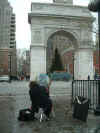 |
New York
Architecture Images-Greenwich Village Washington Square Arch |
|
architect |
McKim, Mead and White |
|
location |
North side of Washington Square Park at Fifth Avenue |
|
date |
1895 |
|
style |
Beaux-Arts |
|
construction |
Tuckahoe marble |
|
type |
Monument |
|
|
click here for a Washington Arch gallery |
|
images |
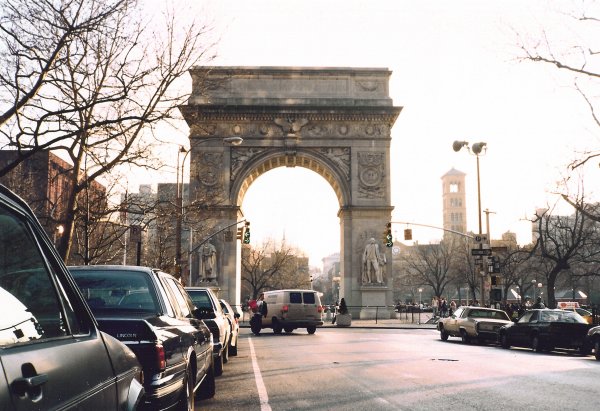 |
| Inspired by Roman triumphal arches, this structure was erected in 1889 to celebrate the centennial of George Washington's inauguration. It replaced an arch on near the site which was a temporary structure made of wood and stucco. Having met with popular approval, Mckim Mead & White's original design was rebuilt in marble in 1891. Decorated with sculptures of Washington in both his civilian and military guises by Alexander Stirling Calder and Herman MacNeil, this arch became the symbol of a new America devoted to the arts. In the first decades of the 20th century, the West Village became an increasingly bohemian neighborhood, and the arch became a site of artistic and social rebellion. Cars no longer pass under the arch as they once did; the Arch remains one of the Village's important urban landmarks. | |
|
|
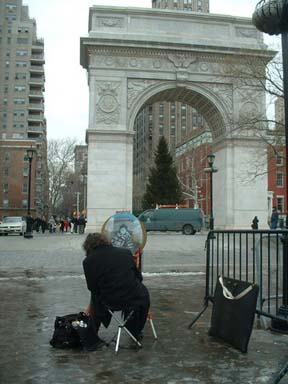 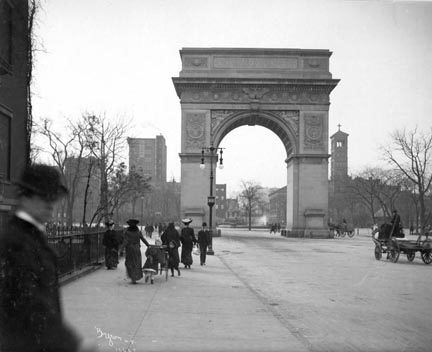 |
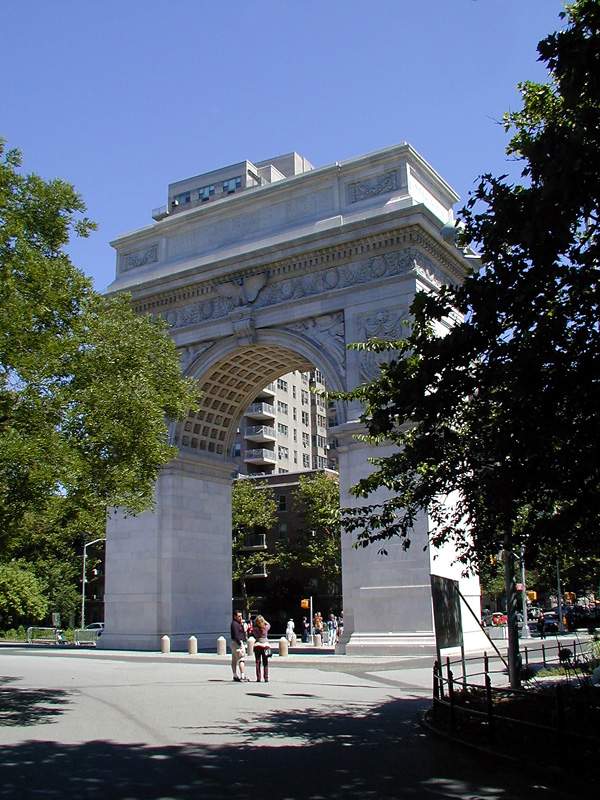 |
|
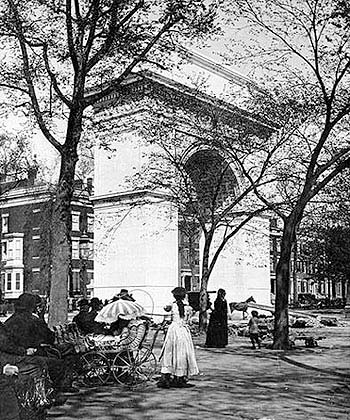 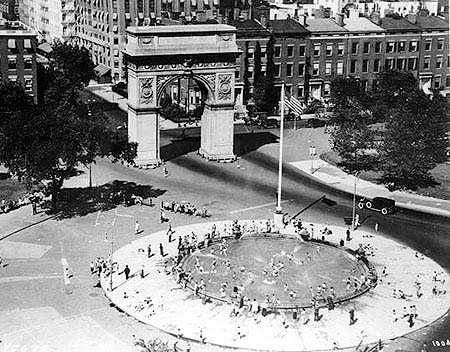 |
|
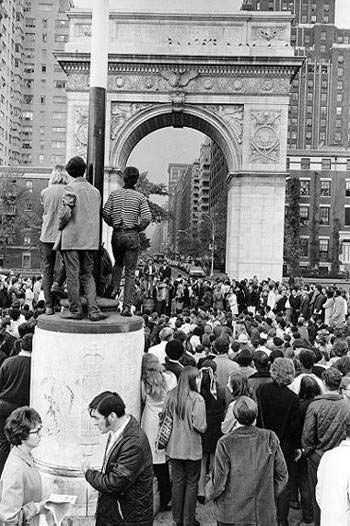 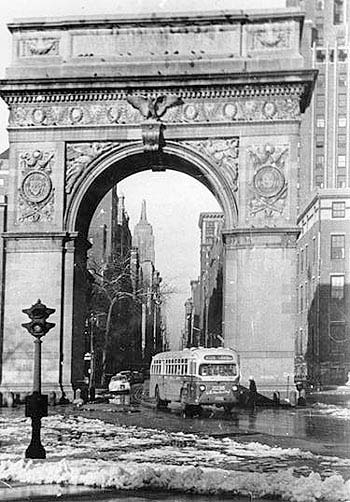 |
|
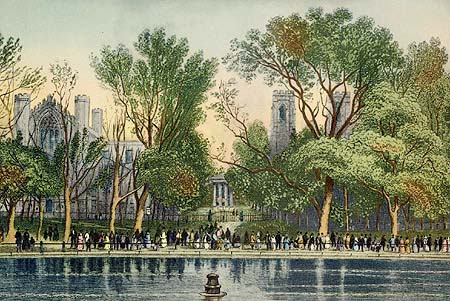  |
|
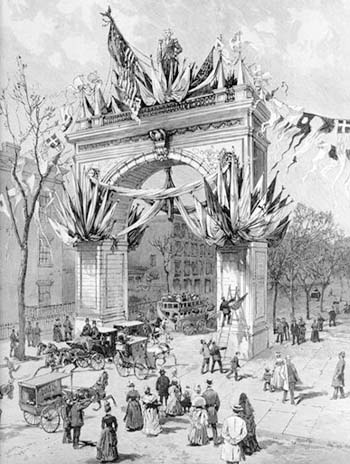 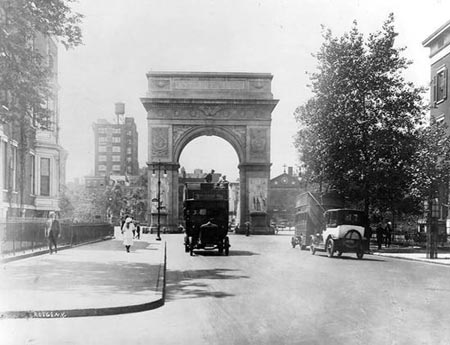 |
|
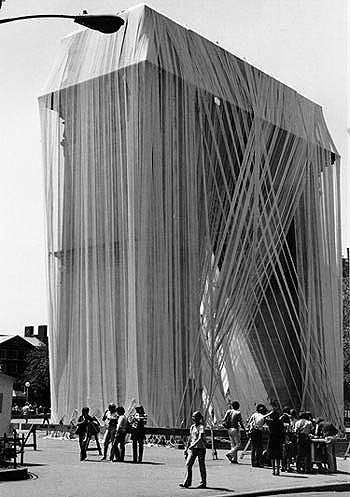 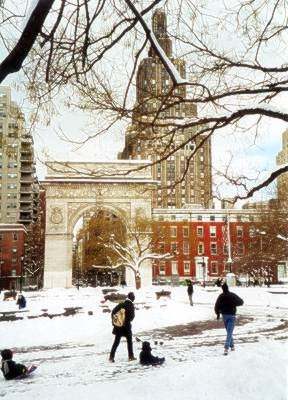 |
|
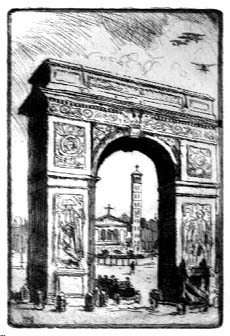 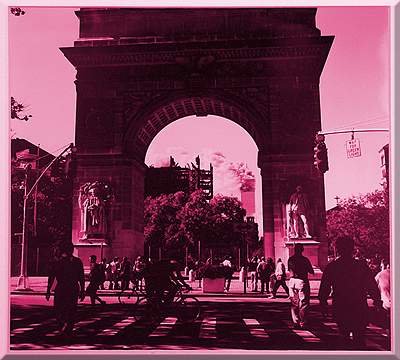 |
|
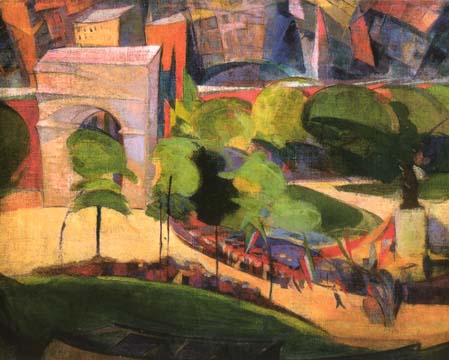 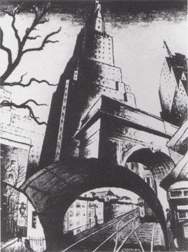 |
|
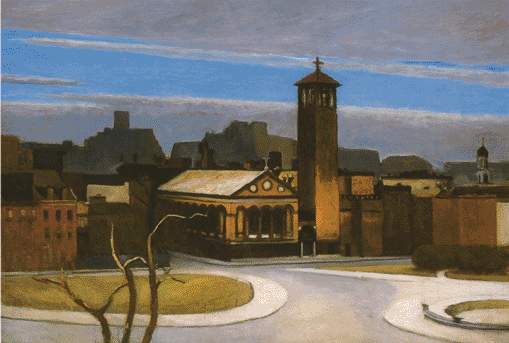 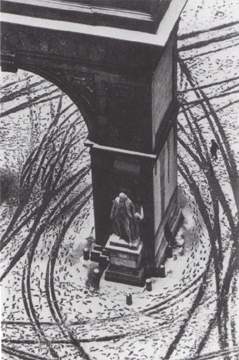 |
|
 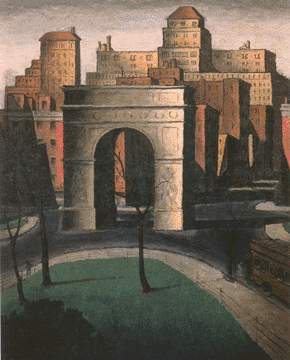 |
|
  |
|
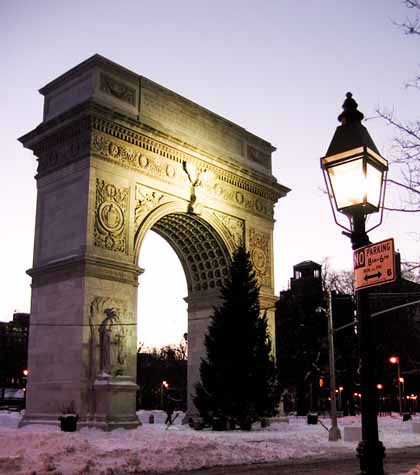 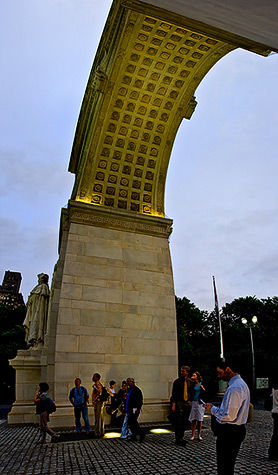 |
|
|
Washington Square Park, a public park since
the 1820's. The park site, at one time marshland with Minetta Brook
running through, was converted to a potter's field and a hanging gallows
prior to its reincarnation as a park. All the streets adjacent to the
Park bear two names: Washington Sq. East=University Place; Washington
Sq. North=Waverly Place; Washington Sq. West=MacDougal Street;
Washington Sq. South=4th Street. Within the Park is the statue of
Garibaldi who lived in NYC in exile in the early 1850's. The statue was
erected by Italian immigrants who began to populate the area south of
the Square in the late 1800's. Also within the Park is the Memorial
Arch, originally in wood, designed by McKim, Mead and White in 1889 to
celebrate the centenary of George Washington's inauguration. "This spot, at least, had changed very little, {Eden Bower} reflected; the same streets, the same fountain, the white arch, and over yonder, Garibaldi, drawing the sword for freedom. There just opposite her was the old red brick house. . . . From somewhere in the crowded quarter south of the Square, a flock of pigeons rose, wheeling quickly upward." (Cather, "Coming, Aphrodite") |
|
|
Less than ten years after Henry James first
published his great "Washington Square", specifically, on April 30, 1890
a five foot square area was cleared of tree and shrub and ground was
broken for the east pier of Washington Square Arch. The crew had just a
month to set the foundation in advance of the ceremony the City planned
for the setting of the cornerstone. However, all work came to an abrupt
halt after a short ten days. The workers had a grisly surprise. Just ten
feet beneath the surface, skeletal remains of human beings were
discovered. They went down another foot or two and every shovelfull of
dirt brought up bones. The residents of Washington Square North
congregated to watch this spectacle. This was a rather exclusive
neighborhood, even then, and this discovery pointed the area out to have
been a "potter's field", a nameless, markerless burial ground for the
absolutely destitute. But one resident, whose name is lost to time, argued with this conclusion. His research had suggested that a paupers' cemetery was only under the south side of the square, and that the prosperous north side had been the site of an old and formal German cemetery. The excavators proved him right, finding the latest headstone dated 1803 on the north end. A class distinction north and south of Washington Square predated the 1828 formation of the square itself. By the 1880's tenements had risen on the blocks to the south, which caused a bit of a stir. Some fought against investing the money to build an elegant arch in a poor neighborhood. At the cornerstone laying on May 30, 1890, Henry Marquand, Chairman of the Citizens Committee on Art, addressed the 6000 invited guests, saying, "It is true that the neighborhood may all be tenement houses in a few years. But have the occupants of tenements no sense of beauty? No patriotism? No Right to good architecture?" With these words he baptised in democracy the Washington Memorial Arch. For over a century , it has made good on his words. The first arch was made of wood, designed by Stanford White, great architect of the age of opulence. It was originally constructed for the Centennial of Washington's Inauguration. The celebration took place on April 30, 1889. Festooned with papier mache wreaths and garlands of flowers, lit up with hundreds of newly invented incandescent lights, the whole thing cost a whopping $2700. The arch was the hit of the ceremonies. Two days later the Marble and final version was commissioned. White also designed that. By April of 1892 the last block was in place, though the arch wasn't dedicated until May 4, 1895! Washington's likenesses were not added until 1916 when the east pier's "Washington at War" by Herman MacNeil was unveiled. Two years later the west pier's "Washington at peace" by A. Stirling Calder was dedicated. Both have suffered erosion during the age of the automobile and the formerly fine features of Washington are pitted and broken down so, he is no longer really recognizable. Perhaps it's time to redo them in bronze. For the next century. Why not? |
|
|
The Washington Square Park, located in the
heart of Greenwich Village, is a very popular and crowded square. It is best known for its bohemian and rebellious character. The park looks seedy, has little green space and attracts vagrants, but people from all backgrounds still flock to the square. The two main attractions in the square are the fountain and the Washington arch. Before the Washington square was built in 1826, the area was used as a burial ground. The north side was a German cemetery, while the south side was a potter's field (a nameless burial ground). The area was later used as a public gallows and execution ground. Between 1829 and 1833, a row of houses were built at the North side of the square. The prestigious houses, built of red Brick in Flemish bond in Greek revival style, became known as 'The Row'. The entrances are flanked by Ionic and Doric columns and have marble balustrades. By the end of the 19th century, the north side continued to attract rich and leading citizens, while the south side was populated with immigrants living in tenement houses. For the Centennial of Washington's inauguration as President of the United States a wooden Memorial Arch was constructed on the Washington Square. The arch, designed by Stanford White was so successful at the celebrations, that a marble version was commissioned. In may 1895 the final version of the 77 ft (23,4m) Washington Arch was inaugurated. The pier sculptures of Washington as general and president were added in 1916 and 1918 respectively. Cars were allowed to drive through the arch until 1971, when the Washington square was redesigned by Robert Nichols. The square has had its ups and downs since. Especially in the 80's, when it had become a drug dealing center, the square was particularly dangerous, but it has improved since the 90's and is now a relatively safe area. The Washington Square park is bounded by Waverly Place, 4th street, University Place and MacDougal Street. The Washington Arch is located at 5th Avenue and Waverly place. |
|
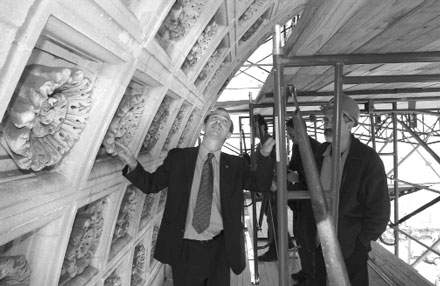 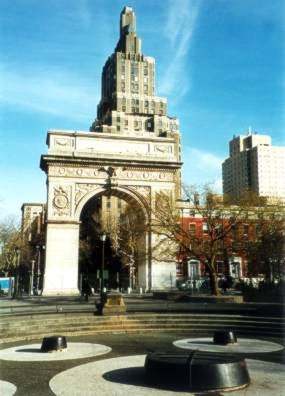 |
|
|
from The Villager Finally, Arch Repair Work Gets Started By Albert Amateau The Parks Department, Village preservationists and elected officials celebrated the beginning of restoration of the Washington Sq. Arch on Wed. April 30, a day that also marked the anniversary of George Washington’s inauguration as first president of the United States. The 108-year-old monument, an international icon of the Village and the city, has been deteriorating over the years as a result of air pollution, neglect and an ill-advised 1964 restoration attempt on the statues of George Washington on the front of the arch. Martha Washington, impersonated by Corinne Heinz, a New York University theater department senior, was at the event, along with Department of Parks and Recreation staff members in 18th century garb. “It’s like a small town here,” said Parks Commissioner Adrian Benepe, introducing preservation advocates long associated with the movement to restore the arch designed by the architect Stanford White and decorated by the sculptors Alexander Sterling Calder, Herman Atkins McNeil and Frederick MacMonnies. Sam White, an architect and Stanford White’s great grandson, attended the event as did Alexander Sterling Calder Rower, great grandson of Calder. “This is a story of patience and partnership,” said Lynne Brown, N.Y.U. senior vice president, noting that the university last year joined neighborhood groups in establishing an endowment fund to maintain the arch. The city capital budget plus allocations by the City Council and Manhattan Borough President C. Virginia Fields, along with private funds from the Samuel H. Kress Foundation have provided the $3 million budget for the restoration. A $600,000 maintenance fund, with $15,000 in annual contributions from N.Y.U., is being raised by public subscription. Benepe announced that Frank Netto, a Washington Sq. W. resident, has pledged a $50,000 contribution to the fund. “It takes a Village to restore a monument,” said Anne-Marie Sumner, president of the Washington Sq. Association, paying tribute to fellow association members including Regina Kellerman, a parks historian. Sumner said she was confident the Parks Department would “restore the arch to its former glory.” City Councilmember Alan J. Gerson, who was raised in the Village, recalled that he spent his childhood playing on the grass of Washington Sq. He paid tribute to Village groups with differing and sometimes conflicting agendas who are united in their dedication to restoring the arch. Passionate concern about the arch has been a tradition in the Village. Adina Gordon, an art historian who lectures at the N.Y.U. Institute of Fine Arts, said later that William Rhinelander Stewart, a benefactor of the arch who lived on Washington Sq. N., kept a critical eye on the craftsmen who carved the figures designed by MacMonnies. “He wanted the angel of peace on one of the spandrels to look like his wife and kept pestering MacMonnies and White about it,” she said. The current restoration phase follows an interim stabilization, with graffiti removal that the Parks Department did five years ago. Work done over the winter included rewiring and preparing the site for the work this spring. Parks officials say the arch will be completed in 2004, possibly in time for the New York University commencement, which takes place in mid-May. The new work will include repairing the statues of George Washington as Soldier, by MacNeil, on the east side of the arch, and as Statesman, by Calder, on the west side. The Washington statues were added to the arch in 1918. The carved spandrel figures, designed by MacMonnies, will be restored and 45 of the 95 rosettes on the underside of the arch will be repaired or replaced. The roof, which has leaked ever since the arch was completed, will also be replaced. “We have letters from White who was concerned about the roof even back then, said John Krawchuck, a Parks expert on antiquities. For the April 30 event, the department opened the spiral stairway within the west leg of the arch that leads to the roof, giving visitors a rare view of the interior brickwork, and a close-up of the worn marble surface as they descended on a scaffold on the outside of the arch. Back around 1914, a group of artists including John Sloan and Marcel Duchamp climbed the spiral staircase to the roof where they lit a bonfire and read a resolution proclaiming the Republic of Greenwich Village, which they toasted with Champagne. Parks Commissioner Adrian Benepe looked at the badly deteriorated rosettes under the arch. He merely touched the edge of one and a bit of it crumbled into dust. Parviz Mohassel, Parks Department construction project manager, is at right. NY1 News April 30, 2004 Washington Square Arch Rededicated After $2.7 Million Makeover The scaffolding came down Friday on a city landmark that underwent a multi-million dollar makeover. The Washington Square Arch was dedicated in 1895, but had deteriorated over time. A one-year, $2.7 million project was launched last year to bring it back to its original condition. Mayor Michael Bloomberg joined city and New York University officials in Washington Square Park this morning for the rededication ceremony, where the mayor took the time to also celebrate "Poem in Your Pocket Day." “Paris has won near the Champs Elysees, MacDonalds are golden like French fries they say. St. Louis has won next to the Mississippi, but for every New Yorker, especially ex-hippie, the arch you love most of all is right there, shining gloriously over Washington Square," said Bloomberg. “It's the core of the neighborhood for us, this square, and most magnificently this arch, which is a part of our university symbol,” said NYU President John Sexton. “We were proud to participate in funding the restoration of the arch.” City Hall donated $2.5 million toward rebuilding the arch. The mayor and City Council have also announced an additional $3 million in funding for the reconstruction of Washington Square Park. Copyright 2004 NY1 News Newsday April 30, 2004 Iconic arch gets facelift BY DEBORAH S. MORRIS Photos: The archway renovation A statue of George Washington got a much-needed face-lift, and a new right hand, thanks to a $2.7-million restoration of the Washington Square Park Arch. After a 14-month restoration project, city officials rededicated the Greenwich Village landmark Friday under sunny skies and to the upbeat tunes of a military band. "For more than 100 years, the arch has stood as a defining symbol of New York City, and has now been restored to its original grandeur," Mayor Michael Bloomberg said before joining first-graders from PS 41 in a ribbon-cutting ceremony. "Today's rededication affirms New York City's commitment to the renewal of Washington Square Park to a beautiful and safe public space for all New Yorkers to enjoy." The arch, designed by architect Stanford White, was dedicated in 1895 and replaced a temporary wooden arch that was erected in 1889 to mark the centennial of George Washington's inauguration. Made of Tuckahoe marble, the arch stands about 72½ feet high and features two statues of George Washington made of Dover marble. One depicts Washington as a general, the other as president. The right hand on the presidential statue had to be recarved; it also received extensive facial repairs. The restoration included recarving or replacing loose or deteriorated pieces, micro-abrasive cleaning, roof replacement and installation of a bird-proofing system. The exterior lighting was also improved. "We are very proud of what we have done with the arch," said Parks Commissioner Adrian Benepe. "For many years it was an eyesore, falling to pieces. There was a chain-link fence around it to protect people from falling rosettes." For about two weeks, first-graders at PS 41 in Greenwich Village, just blocks from the park, learned about the arch and its importance in history. "It was a gift to remember George Washington," said Samir Belkas, 6, who often plays in the park with his family and helped plant flowers near the arch with his class. "And it was made of wood. It was fun to learn about the arch." Although most in attendance were impressed by the improvements and the plans to spruce up the rest of the park, one regular visitor was not buying into the day's festivities. "It's like parent visiting day at camp," said Alex King, of Greenwich Village, who was enjoying the weather with her daughter, Maya Wissak, 3. "I'm happy that they have fixed the arch, but the rest of the park is not up to date, so they have a long way to go." Indeed. Restoring the arch is just the first step in returning the park to its former splendor. More than $3 million in city and private money has been pledged for renovations. Copyright 2004 Newsday, Inc. |
|
|
Washington Sq. redesign to go
public; some think it’s too late |
|